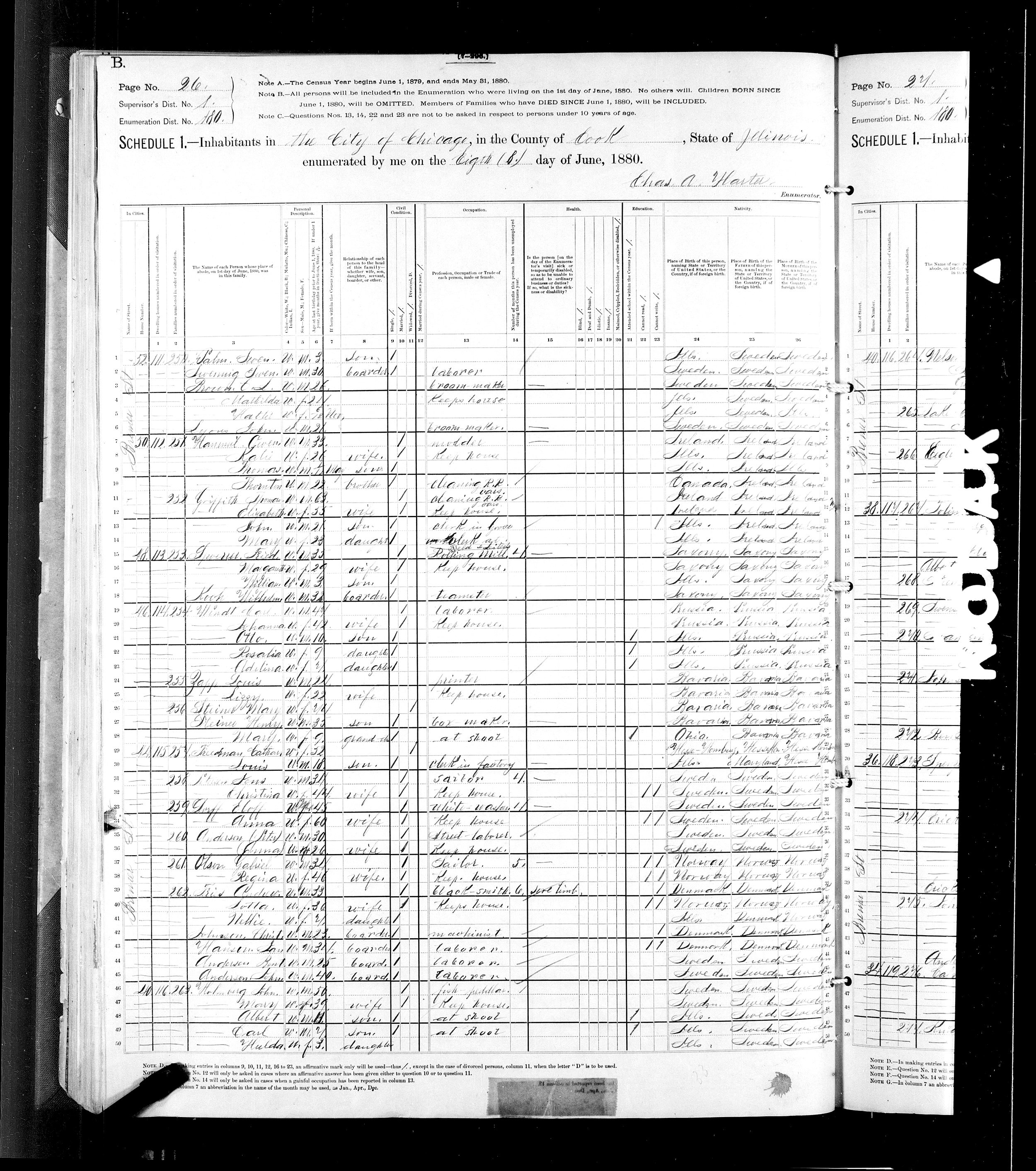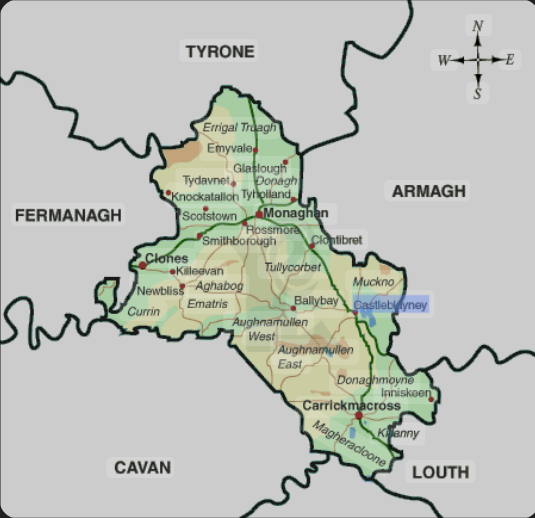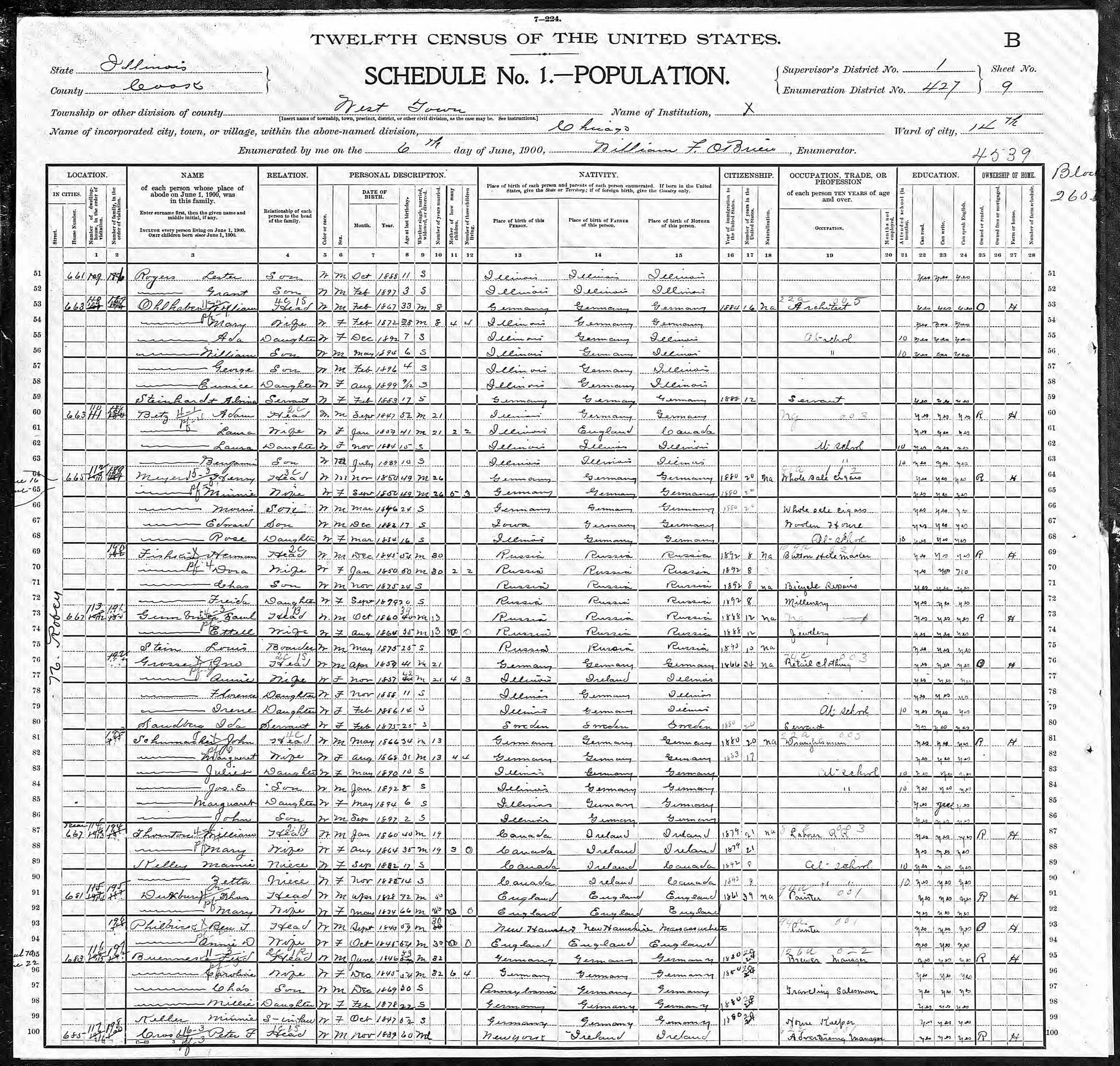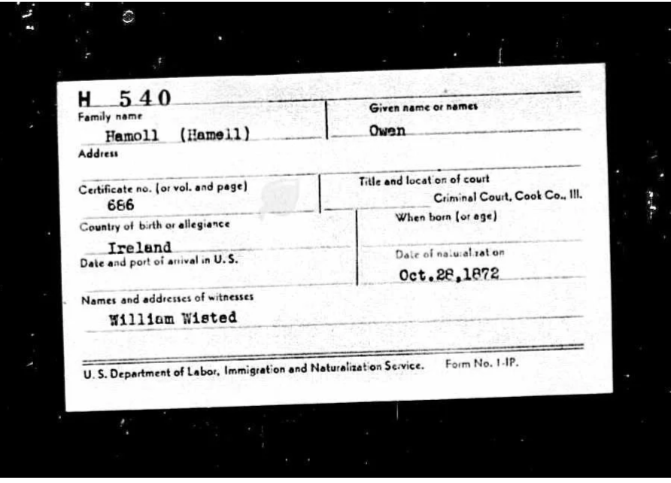The Missing Brother Mystery
How "Thornton Hamall" Became William Thornton
Deep dive into the Owen Hamall case study methodology - When a mysterious census entry led to discovering Owen's half-brother through their mother's second marriage
Historic Chicago Street Scene
The Research Challenge
Initial Research Question
Who was "Thornton Hammil" listed as Owen's brother in the 1880 Chicago census, when no such person existed in any other records? The 1880 U.S. Census provided the only clue to this mysterious family member, but raised more questions than it answered.
1880 U.S. Census showing the “Hammil” household with "Thornton Hammil" listed as Owen's brother - the mysterious entry that launched six years of investigation
Known Information at Project Start
Owen Hamall married Catherine "Kate" Griffith in Chicago in 1879
1880 U.S. Census showed Owen, Kate, baby Thomas, and mysterious "William Thornton" as brother
Baby Thomas (Thomas Henry Hamall) was our family ancestor - the connection that initiated research into Owen's identity and family backgroundKnown Information at Project Start
What We Didn't Know
Owen was an iron molder by trade
Four additional children existed who died between censuses
Family appeared on Chicago Tribune's "Destitute List" in 1897
Owen died of meningitis in 1898
Sister Mary existed and survived to adulthood
Complete Irish origins and Canadian immigration story
Research Obstacles Identified
Name variations: Hamill/Hamall/Hammall spellings across jurisdictions
Missing vital records: No birth certificate or ship manifest
Census gaps: Family disappeared between enumeration years
Geographic complexity: Three-country migration requiring multi-jurisdictional research
Economic invisibility: Working-class family with minimal institutional documentation
Systematic Research Methodology
Comprehensive Record Collection
Irish Sources:
National Library of Ireland parish records (Donaghmoyne, County Monaghan)
Griffith's Valuation property records
Irish civil registration records post-1864
Canadian Sources:
Library and Archives Canada census records (1851, 1861, 1871)
Montreal city directories and church records
Quebec vital statistics registrations
United States Sources:
Minnesota naturalization records (Blue Earth County, 1868)
Illinois naturalization completion (Cook County, 1872)
Chicago city directories (1874-1897)
Cook County marriage and death records
Catholic parish registers (baptism, marriage, burial)
Evidence Analysis and Correlation
Critical Document Analysis:
1861 Canadian Census: Owen (age 18) listed as apprentice in Montreal's St. Anne Ward
1868 Minnesota Declaration: Owen filed naturalization intention in Blue Earth County
1872 Illinois Naturalization: Process completed in Cook County Circuit Court
1879 Marriage Record: Owen married Catherine Griffith, both residing on Bremer Street
1880 U.S. Census: Shows Owen, Kate, baby Thomas, and mysterious "William Thornton" as brother
1888 and 1892 Chicago Voter Registrations: Tracked Owen's residential changes and civic participation
1898 Death Certificate: Final documentation of Owen's death from meningitis
Calvary Cemetery Cards: Burial records and plot documentation
Evidence Quality Assessment:
Primary sources: 15 documents directly naming Owen Hamall
Secondary sources: 8 documents providing family context
Corroborating evidence: Multiple record types confirming same facts
Systematic Investigation: Years of methodical searching across Irish, Canadian, and American records without finding the crucial connection. The family relationships remained elusive despite comprehensive record collection across multiple jurisdictions and source types.
The Missing Link: Traditional genealogical approaches failed to connect "Thornton Hamall" from the 1880 census to any identifiable person or family. Standard naming pattern searches, geographic clustering analysis, and immigration record correlation yielded no definitive results.
Family Network Reconstruction
The Breakthrough Discovery: After six years of systematic research, the crucial breakthrough came in March 2024: an 1883 baptism record for Owen's son William listed "William Thornton" as sponsor—the first concrete connection between Owen and the mysterious "Thornton" surname.
Critical Validation: Following this discovery, the 1861 Canadian census was located—the only document that showed both Thorntons and Hamalls on the same record, providing definitive proof that the families lived together as a blended household in Montreal. This census validation came after the baptism discovery and confirmed the family relationships that the baptism record had suggested.
This discovery transformed the research from solving Owen's mystery to reconstructing William Thornton's complete family story. The subsequent year (March 2024-2025) involved systematic investigation of William's life: his 1881 marriage to Mary Lynch in Canada, their children who died between censuses, his own death from exposure in Chicago in 1900, and his widow Mary's subsequent remarriage and later death in New Hampshire.
This expansion demonstrates how one genealogical breakthrough often opens multiple new research avenues, requiring sustained investigation to understand complete family networks rather than isolated individuals. Following family lines beyond the immediate research question reveals broader patterns of migration, survival, and adaptation.
Reciprocal Family Bonds Revealed: Further research showed Owen and Catherine Hamall served as sponsors for William Thornton's daughter Mary Margaret on June 3, 1883, at Holy Name Cathedral, State Street, Chicago. This reciprocal sponsorship pattern demonstrated active, ongoing family relationships between the half-brothers and their families.
Map of County Monaghan showing Donaghmoyne Parish
The Breakthrough Discovery
1883 baptism record showing "William Thornton" as sponsor
Sequential Evidence Building:
Mother's Second Marriage: Church records revealed Mary McMahon married Patrick Thornton in Montreal, 1855. Church marriage documentation specifically states "widow of Henry Hamall married Patrick Thornton"
Blended Family Structure: William Thornton was Owen's half-brother through maternal remarriage
Geographic Confirmation: William Thornton appeared on the 1880 census with Owen in Chicago, married in early 1880 in Canada, had children born in Chicago, and died in Chicago in 1900
Research Challenges: The Pattern of Lost Children
The research revealed a tragic pattern: like Owen and Kate, William Thornton and his wife Mary Lynch Thornton had children who were born and died between census enumerations, making them nearly invisible to genealogical research.
William Thornton's Family Reconstruction:
Marriage: August 20, 1881, Granby, Quebec - William Thornton (son of Patrick Thornton and M McMahon) married Mary Jane Lynch
1900 Census Challenge: Listed with wife Mary and two nieces, but census specified "3 children, 0 living"
Cemetery Discovery: Death records revealed two children buried in the same grave as William Thornton at Calvary Cemetery, Chicago
Wife's Full Identity: Mary Lynch Thornton St Pierre (1858-1936)
The Tragic Parallel: Both Brothers' Final Years
The research revealed heartbreaking parallels between the half-brothers' final circumstances:
Owen Hamall (1898):
Listed on Chicago Tribune's "Destitute List" in 1897
Died blind and impoverished at age 51
Family reduced to public charity assistance
William Thornton (1900):
Found with both hands and feet frozen on February 1, 1900
Taken to County Hospital but survived the immediate crisis
Listed among "Other Victims of the Weather" in Chicago Tribune
Found at address listed as Taylor freight depot area (corner Sherman) in February
June 6, 1900 Census: Living on Robey Street with wife Mary and two nieces (Mary's relatives)
Died September 7, 1900 in Metropolis, Massac County, Illinois
Wife Mary Lynch Thornton remained in Chicago until at least 1906, remarried in 1908
Research Questions: The timeline shows William recovered enough from his February injuries to be living with his family on Robey Street by June. What circumstances led him to Metropolis between June and September 1900? The geographic separation from his wife suggests work, medical treatment, or other factors that remain undocumented.
Both brothers, who had supported each other's families through baptismal sponsorships in 1883, died in poverty within two years of each other. The contrast between their mutual family support in the 1880s and their individual struggles in the 1890s illustrates the precarious nature of working-class immigrant life in industrial Chicago.
1900 U.S. Census showing William Thornton, wife Mary, and two nieces, with notation "3 children, 0 living
February 1, 1900 Chicago Tribune headline "Cold Brings Death to Two”
William Thornton 667 North Robey Street, found at Taylor and Sherman streets with both hands and feet frozen; taken to County Hospital
Other Victims of the Weather
Documentary Evidence Analysis
Primary Source Authentication
Document Reliability Framework:
Original records: Church registers, government certificates, contemporary newspapers
Contemporary copies: City directory listings, voter registrations
Later transcriptions: Cemetery records, family Bible entries
Cross-Reference Validation: Each major life event required confirmation from minimum two independent sources before acceptance as established fact.
1900 freight depot listing showing Taylor depot location at corner Sherman - indicating where William was found frozen
Owen's 1872 naturalization documentation from Cook County
Conflicting Evidence Resolution
Example Challenge: Owen's death certificate listed birthplace as "Ireland" while naturalization papers specified "Great Britain"
Resolution Process:
Historical context research: Post-1800 Act of Union made Ireland part of "Great Britain" for legal purposes
Pattern analysis: Examined how other Irish immigrants' records handled this distinction
Temporal consideration: Earlier documents more likely to use "Great Britain," later ones "Ireland"
Conclusion: Both designations were legally correct for the time periods involved
This three-document analysis demonstrates how even family members (Thomas Henry) can lack accurate knowledge of ancestral origins, emphasizing the importance of systematic documentary research over oral tradition alone.
Three-document comparison showing conflicting birthplace information: Owen's 1898 death certificate (birthplace blank), 1868 naturalization declaration ("Great Britain"), and son Thomas Henry's 1938 death certificate ("father born Canada, location unknown
The Complete Family Journey
Ireland: The Famine Years (1847-1850)
Historical Context: Owen's birth in 1847 occurred during the darkest year of An Gorta Mór (The Great Hunger). The Hamall family's decision to emigrate placed them among approximately one million Irish who fled famine between 1845-1855.
Parish Research Findings:
Henry Hamall and Mary McMahon married in Donaghmoyne parish, 1845
Owen baptized 1847 during peak famine mortality
Family emigrated circa 1850, following common post-famine migration patterns
Montreal: Canadian Immigration (1850-1867)
Settlement Pattern Analysis: The Hamall family's choice of Montreal over American ports reflected economic constraints common to famine refugees. Shorter Atlantic crossing to British North America offered lower passage costs.
Family Reconstruction:
1851: Sister Mary died at age 4; brother Michael born
1853: Sister Mary Ann born in Montreal
1854: Father Henry died at age 37, leaving Mary widowed with young children
1855: Mary married Patrick Thornton, creating blended family
1856: Half-brother William Thornton born
Social Integration: By 1861, Owen worked as apprentice in Montreal's St. Anne Ward, a predominantly Irish Catholic neighborhood that provided community support for immigrant families.
Chicago: American Settlement (1867-1898)
Migration Pattern: Owen's appearance in Minnesota by 1868 reflects post-Civil War westward movement of skilled immigrants. His eventual Chicago settlement aligned with the city's industrial boom following the Great Fire of 1871.
Occupational Development: As iron molder, Owen entered a skilled trade essential to industrial expansion. The profession required strength, precision, and tolerance for dangerous conditions—characteristics that would later be tested by his blindness.
Family Establishment:
1879: Marriage to Catherine Griffith, neighbor from Bremer Street
1880-1890: Six children born, four died in childhood from common diseases
1890s: Owen's health declined, family faced increasing poverty
1897: Listed on Chicago Tribune's "Destitute List"
1898: Owen died of meningitis at age 51
Images -County Monaghan map showing Donaghmoyne parish → 1861 Census Canada East showing Thorntons and Hamalls living together with Owen as apprentice → Bird's-eye view of Chicago business district showing the complete geographic and documentary journey from Irish origins through the crucial blended family evidence to industrial American destination
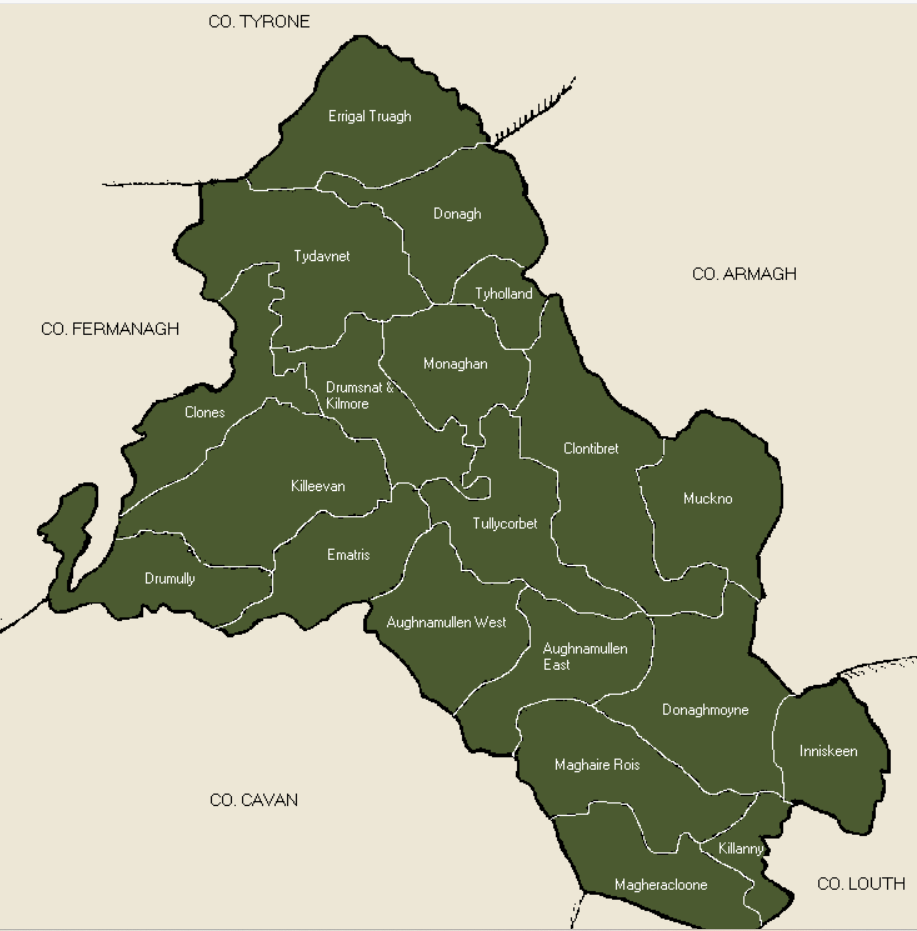
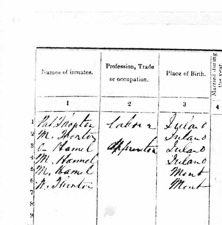

Research Innovations and Methodology Contributions
Multi-Jurisdictional Coordination
Challenge: Coordinating records across Irish, Canadian, and American archives with different cataloging systems and access procedures.
Solution: Developed systematic approach to trans-Atlantic genealogical research, including:
Jurisdiction-specific research strategies
Timeline correlation across different record-keeping systems
Currency and measurement conversions for historical context
Evidence-Based Narrative Construction
Innovation: Transformation of genealogical research into compelling family narrative while maintaining strict adherence to documented evidence.
Process:
Factual foundation: All narrative elements grounded in primary sources
Historical context: Research into period-specific conditions (famine, immigration, urban poverty)
Emotional authenticity: Character development based on documented circumstances
Legacy creation: Translation of historical struggle into contemporary inspiration
Professional Standards Compliance
Board for Certification of Genealogists (BCG) Standards Applied
Reasonably Exhaustive Research: Systematic examination of all relevant source categories across three countries, with documentation of negative evidence where records should exist but were not found.
Complete and Accurate Source Citations: All sources cited following Evidence Explained standards, with full repository information and access dates for digital collections.
Analysis and Correlation of Evidence: Documented analysis of each piece of evidence, including reliability assessment and correlation with other sources before drawing conclusions.
Resolution of Conflicting Evidence: Systematic approach to resolving discrepancies, with explanation of reasoning and acknowledgment of remaining uncertainties.
Sound Conclusions Based on Strongest Evidence: All conclusions supported by preponderance of evidence, with clear distinction between proven facts and reasonable inferences.
Research Outcomes
Questions Resolved
Identity of "brother Thornton": William Thornton identified as half-brother through mother's second marriage
Four "lost" children: Cemetery records revealed William, Lizzie, Katie, and Eugene who died between censuses
Complete migration pattern: Documented journey from Donaghmoyne to Montreal to Chicago
Family economic trajectory: From Irish subsistence farming to skilled American labor to urban poverty
Community connections: Identified network of families from same Irish parish
Professional Methodology Contributions
Immigrant Family Research Framework:
Origin-point parish research to establish baseline family structure
Migration route documentation using naturalization and ship records
Destination community analysis to understand settlement patterns
Economic adaptation tracking through occupational records
Family network reconstruction using church and civil records
Client Deliverables
Complete Documentation Package
Ancestral Sketch Report (21 pages):
Complete life summary with historical context
Professional timeline with source citations
Social history placing family in broader immigration narrative
Photo section with historical maps and documents
Family stories section interpreting research findings
Digital Archive:
High-resolution scans of all source documents
Research log with complete search strategies
Evidence analysis worksheets
Methodology notes for future researchers
Narrative Transformation: "The Fire in Your Blood"
Professional Storytelling:
Transformation of genealogical data into compelling family legacy
Historical accuracy maintained throughout narrative
Emotional resonance created through character development
Contemporary relevance established through themes of resilience
When to Apply This Methodology
Ideal Candidates for This Approach:
Multi-generational immigrant families with gaps in documentation
Common surnames requiring unique identifier strategies
Families with migration across multiple jurisdictions
Cases where traditional genealogy has reached dead ends
Clients seeking narrative legacy creation beyond basic family trees
Core Framework Components:
Systematic source categorization by jurisdiction and time period
Evidence quality assessment for each document type
Timeline correlation across multiple record systems
Network analysis to identify family associates and community connections
Narrative integration to create meaningful family legacy
Access Complete Research Materials
Read "The Fire in Your Blood" Family Narrative
See how this genealogical research transformed into an inspiring family legacy story
Read “The Missing Brother Mystery”
When mysterious census entries unlock complex family stories that span continents and generations
View Our Professional Services
Learn about comprehensive genealogical research and narrative storytelling for your family
Schedule Your Research Consultation
Discuss how these methodologies can unlock your family's hidden stories
This methodology demonstrates Storyline Genealogy's commitment to Board for Certification of Genealogists professional standards while creating meaningful family narratives that honor both historical accuracy and human experience.
© 2025 Storyline Genealogy. All rights reserved.
.


